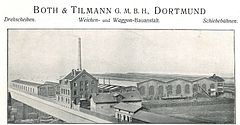Both & Tilmann
| Both & Tilmann GmbH
|
|
|---|---|
| legal form | GmbH |
| founding | 1893 |
| resolution | 1920 |
| Seat | Dortmund |
The Both & Tilmann GmbH was a mechanical engineering company based in Dortmund. It emerged from the company of the same name founded in 1890 by the engineer Josef Both.
history
After the engineer Josef Tilmann joined Josef Both's company as an employee and then as a partner, both founded the Both & Tilmann company with a contract dated January 2, 1893. The share capital was 160,000 Mk. The company's first location was on Lindenstrasse in Dortmund, near the main train station. The manufacturing facilities there soon became too small. Since they were also in the middle of the city, an extension was not possible. Therefore, in the years 1896/1897, a new plant was built in the north of the city on Glückaufstrasse and Schlägelstrasse, based on the most modern principles.
Due to illness, the co-founder Josef Both left the management in 1902. With a contract dated April 1, 1906, the long-time employees engineer Franz Otte and businessman CA Ulrich were taken on as additional partners. On April 1, 1920, all shares were taken over by Eisen- und Stahlwerke Hoesch AG . The management initially remained in the hands of Director Otte.
As a result of the global economic crisis, Both & Tilmann GmbH was placed under the management of Maschinenfabrik Deutschland (MFD) , which was also part of the Hoesch Group in 1929 . The construction of points and crossings from grooved rails, especially for trams, the company's core competence, was relocated to MFD due to the associated efforts to rationalize. The production of the other products, which did not belong to the core business, was given up and the halls of the company Both & Tilmann were used for other purposes.
In the difficult years of the Weimar Republic and the Great Depression, Hoesch AG was one of the few heavy industry companies that were not integrated into the United Steel Works . In 1930 Hoesch merged with the Cologne-Neu-Essen mining association , and in 1966 with the Dortmund-Hörder Hüttenunion . In 1991, Hoesch AG was finally bought up by what was then the Krupp Group in a hostile takeover .
Business areas
The company's production spectrum included the following areas:
- Point construction department
The company acquired great expertise in the construction of points made of grooved and Vignole rails for main and trams. Particular attention was paid to the design of switch devices in grooved rails. This was also reflected in a point- setting device protected by DRP .
- Wagon construction department
all types of freight cars for both standard gauge and narrow gauge were produced here. In the years between 1910 and 1920 the wagon construction department delivered a total of 3930 freight wagons - mostly coal wagons - worth almost 12 million marks to the state railway. In the following years up to 1924 the EZA (Central Railway Authority) commissioned a further 1518 cars. It was about wagons of the association types according to the sample sheets A 2, A 4, A 5, A 6, A 7 and A 10 as well as a number of refrigerator wagons. Missing orders from EZA during the global economic crisis meant that the corporate division was almost idle.
- Trolley construction department
The company also acquired great expertise through the development and construction of trolleys , also known as transporters. Several types protected by DRP have been developed. Due to the low overall height, standard gauge wagons could be bolstered using simple head ramps. The cumbersome use of trolley pits was thereby eliminated.
Product gallery
Some samples are shown here as examples of the company's products. They come from both a company's product catalog from around 1905 and books on contemporary German railways in the 1911 and 1923 editions.
literature
- Erhard Born / Wolf D. Groote: The Hohenlimburg small train . 1st edition. Kenning, 2011, ISBN 978-3-933613-26-4 .
- Hof / Krumbier / Anger: The German railway system of the present . Reimar Hobbing, Berlin 1923.
Individual evidence
- ↑ The railway system of the present. Reiman Hobbing Publishing House, Berlin, 1923 edition
- ^ E. Born, Wolf D. Groote: The Hohenlimburg small train. Kenning publishing house
- ↑ The railway system of the present. Reiman Hobbing Publishing House, Berlin, 1923 edition
- ^ Born, Groote: The Hohenlimburg small train. (from the Hoesch company archive)










